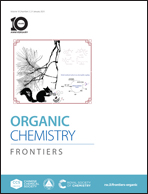Cu(i)-catalysed asymmetric intramolecular tandem oxaziridination/rearrangement reaction: theoretical insight into the mechanism, enantioselectivity, ligand effect, and comparison with the corresponding Lewis-acid-promoted reaction†
Abstract
In the present study, theoretical calculations were performed to gain a deeper understanding of the copper(I)-catalysed asymmetric intramolecular tandem oxaziridination/rearrangement reaction. The results suggest that the Cu(I)-catalysed asymmetric reaction firstly facilitates the generation of the key active Cu–nitrene species. The subsequent catalytic cycle involves asymmetric oxaziridination, ligand exchange, and 1,2-alkyl shift accompanied by oxaziridine ring opening. The oxaziridination step is critical for determining the enantioselectivity of the reaction and the main product configuration is verified to agree with the experimental observation very well. The preference for the formation of (S)-lactam is due to the attractive C–H/π interactions and the avoidance of repulsion. Compared with the Cu(I)-catalysed asymmetric reaction, the Lewis acid-promoted asymmetric Schmidt reaction exhibits quite different mechanistic characteristics, taking place via a one-step process, where C–N bond formation, 1,2-alkyl shift, and N2 release occur simultaneously. The use of the large bisoxazoline-type ligand was essential for achieving high enantioselectivity in the Cu(I)-catalysed asymmetric reaction. More importantly, by analyzing the origin of the ligand-controlled reactivity for the Cu system, we found that the binding energy for different ligands in the rate-determining N2 liberation step mainly determines the observed reactivity. Additionally, this study should be of some worth in forecasting how different substrate substituents affect the product yield.



 Please wait while we load your content...
Please wait while we load your content...